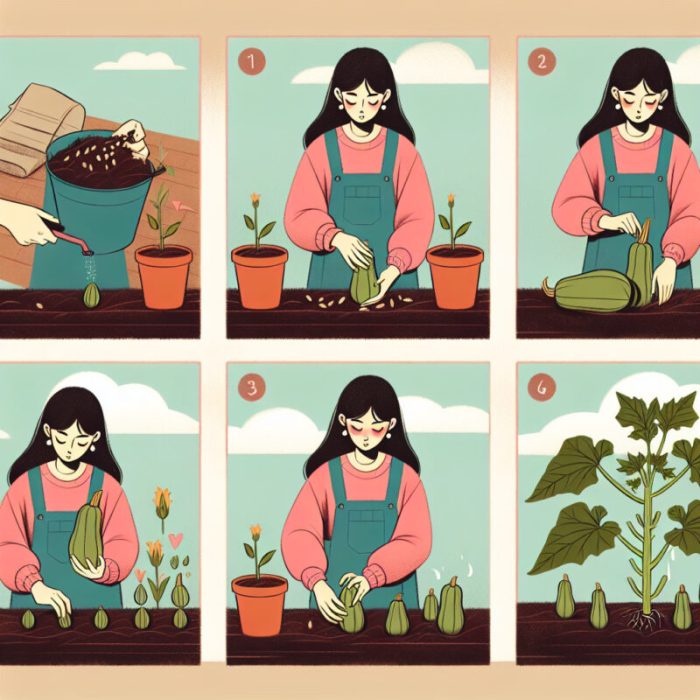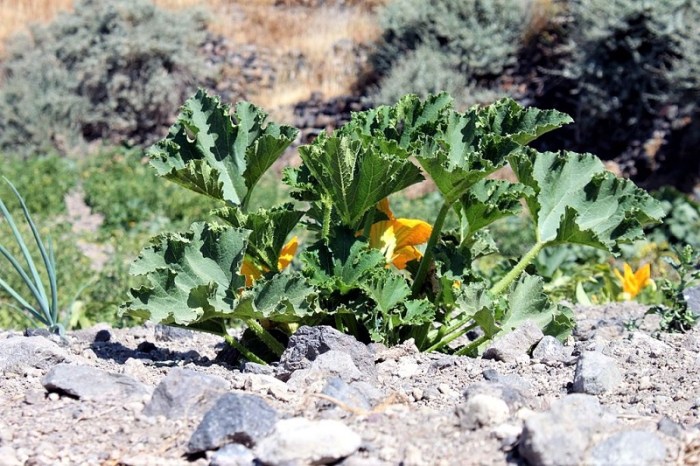How to Plant Zucchini From Seed
Choosing the Right Zucchini Seeds

Source: plantopiahub.com
How to plant zucchini from seed – Selecting the right zucchini seeds is crucial for a successful harvest. The variety you choose will significantly impact your yield, disease resistance, and the overall characteristics of the fruit. Consider factors like your growing season length, desired fruit size, and personal preferences when making your selection.
Zucchini Variety Comparison
Different zucchini varieties offer unique traits. The following table compares some popular options.
| Variety | Growth Habit | Disease Resistance | Fruit Characteristics |
|---|---|---|---|
| Black Beauty | Bushy | Moderate | Dark green, cylindrical, 8-10 inches long |
| Costata Genovese | Bushy | Good | Light green with dark green ribs, 6-8 inches long |
| Golden Zucchini | Bushy | Moderate | Yellow, cylindrical, 6-8 inches long |
| Round Zucchini | Bushy | Moderate | Round, light green, 4-6 inches in diameter |
Seed Quality and Sourcing
Using high-quality seeds from reputable suppliers is essential for maximizing your chances of success. Reputable suppliers ensure proper seed storage and handling, leading to higher germination rates and healthier plants. Look for seeds that are clearly labeled with the variety name, germination rate, and planting instructions. Avoid purchasing seeds from unknown sources or those with damaged packaging.
Hybrid vs. Heirloom Zucchini Seeds
Hybrid zucchini seeds are produced by cross-pollinating two different varieties, resulting in plants with enhanced characteristics like increased yield and disease resistance. However, seeds saved from hybrid plants will not produce true-to-type offspring. Heirloom zucchini seeds, on the other hand, are open-pollinated, meaning the seeds saved from the plants will produce similar plants in subsequent generations. While heirloom varieties might have lower yields compared to hybrids, they offer greater genetic diversity and are often preferred by gardeners who want to preserve traditional varieties.
Starting Zucchini Seeds Indoors
Starting zucchini seeds indoors gives your plants a head start, allowing for an earlier harvest. This is particularly beneficial in areas with shorter growing seasons. Proper techniques are essential to ensure healthy seedlings.
Indoor Seed Starting Guide
Follow these steps for successful indoor seed starting:
- Choose a seed starting mix: Use a well-draining seed starting mix, not garden soil.
- Select appropriate pots: Use small pots (2-3 inches in diameter) or seed starting trays.
- Plant the seeds: Sow seeds about ½ inch deep and 1 inch apart.
- Maintain ideal temperature: Keep the soil temperature between 70-80°F (21-27°C) for optimal germination.
- Provide adequate light: Use grow lights or place seedlings in a sunny location.
- Water consistently: Keep the soil moist but not soggy.
- Thin seedlings: Once seedlings have a few true leaves, thin to one plant per pot.
Proper Watering and Germination
Consistent moisture is crucial during germination, but overwatering can lead to damping off (a fungal disease that kills seedlings). Water thoroughly when the soil surface feels dry to the touch. Ensure good drainage to prevent waterlogging.
Hardening Off Seedlings
Before transplanting outdoors, gradually acclimate your seedlings to outdoor conditions through a process called hardening off. This involves gradually increasing their exposure to sunlight, wind, and temperature fluctuations over a period of 7-10 days.
Preparing the Planting Site
Proper site preparation is essential for healthy zucchini growth. This involves optimizing soil conditions and removing any potential obstacles to plant development.
Pre-Planting Checklist
Before planting, complete the following tasks:
- Soil testing: Determine your soil’s pH and nutrient levels.
- Amendments: Add compost or other organic matter to improve soil structure and fertility.
- Weed removal: Eliminate weeds to reduce competition for nutrients and water.
- Sun exposure: Ensure the site receives at least 6-8 hours of direct sunlight per day.
- Drainage: Ensure the soil drains well to prevent waterlogging.
Ideal Soil Conditions, How to plant zucchini from seed

Source: theownerbuildernetwork.co
Zucchini thrives in well-drained soil with a slightly acidic to neutral pH (6.0-7.0). Amend heavy clay soils with organic matter to improve drainage and aeration. Sandy soils may benefit from the addition of compost to increase water retention.
Soil Amendment Comparison
| Amendment | Benefits | Application Rate | Notes |
|---|---|---|---|
| Compost | Improves soil structure, adds nutrients | 2-4 inches | Well-rotted compost is best |
| Peat Moss | Improves drainage in clay soils, increases water retention in sandy soils | 1-2 inches | Can lower soil pH |
| Vermiculite | Aids in water retention and aeration | 1-2 inches | Inorganic, lightweight |
| Aged Manure | Adds nutrients, improves soil structure | 2-4 inches | Avoid fresh manure |
Planting Zucchini Seeds Outdoors
Direct sowing zucchini seeds outdoors is a common method, especially in warmer climates. Proper technique ensures optimal germination and seedling establishment.
Direct Sowing Technique
Plant seeds about 1 inch deep and 2-3 feet apart, in hills or rows. Space hills 3-4 feet apart. This spacing allows for adequate growth and prevents overcrowding.
Challenges of Direct Sowing
Direct sowing can be challenging due to potential pest infestations (e.g., squash bugs, vine borers) and unpredictable weather conditions (e.g., late frosts, drought). Protecting seedlings from pests and providing supplemental watering during dry spells might be necessary.
Suitable Outdoor Planting Site
Choose a sunny location with well-drained soil. Protect the planting site from strong winds, which can damage delicate seedlings. Amend the soil with compost or other organic matter to improve fertility and drainage.
Caring for Zucchini Plants: How To Plant Zucchini From Seed
Providing adequate care throughout the growing season is essential for maximizing zucchini yield and quality. This involves consistent watering, fertilization, and pest and disease management.
Watering Schedule
Water deeply and regularly, especially during dry periods. Aim to keep the soil consistently moist but not waterlogged. The frequency of watering will depend on weather conditions and soil type. Mulching around the plants can help retain soil moisture.
Fertilizing Zucchini Plants
Apply a balanced fertilizer (e.g., 10-10-10) according to package directions. Side-dress with compost or other organic matter to provide additional nutrients throughout the growing season. Avoid over-fertilizing, which can lead to excessive vegetative growth at the expense of fruit production.
Pest and Disease Management
Common zucchini pests include squash bugs, squash vine borers, and aphids. Common diseases include powdery mildew and blossom-end rot. Regular monitoring for pests and diseases is crucial. Use appropriate methods for prevention and control, such as handpicking pests, using insecticidal soap, or applying fungicides if necessary.
Harvesting Zucchini
Harvesting zucchini at the right time ensures optimal flavor and texture. Regular harvesting also encourages continuous production.
Ideal Harvest Time
Harvest zucchini when they are 6-8 inches long and have smooth, tender skin. Larger zucchini tend to be less tender and may develop seeds.
Importance of Regular Harvesting
Regular harvesting stimulates the plant to produce more fruit. Leaving zucchini on the vine for too long can reduce the plant’s productivity and result in tough, seedy fruit.
Stages of Zucchini Growth
The visual representation below illustrates the different stages of zucchini growth from seedling to harvest.
- Seedling Stage: Small plant with cotyledons (seed leaves) and a few true leaves.
- Vegetative Growth Stage: Rapid growth of leaves and stems.
- Flowering Stage: Appearance of male and female flowers.
- Fruit Development Stage: Rapid growth of zucchini fruits.
- Harvest Stage: Mature zucchini ready for harvesting.
Troubleshooting Common Problems
Despite careful planning and execution, several issues can arise when growing zucchini. Understanding the causes and solutions to these problems is essential for successful cultivation.
Troubleshooting Table
| Problem | Cause | Solution | Prevention |
|---|---|---|---|
| Poor Germination | Cold soil temperatures, dry soil, poor seed quality | Improve soil temperature, ensure adequate moisture, use high-quality seeds | Plant seeds at the right time, maintain proper soil moisture |
| Yellowing Leaves | Nutrient deficiencies, overwatering, pest infestations | Apply fertilizer, adjust watering, control pests | Regular soil testing, proper watering, pest monitoring |
| Blossom-End Rot | Calcium deficiency, inconsistent watering | Apply calcium-rich fertilizer, maintain consistent soil moisture | Soil testing, consistent watering practices |
Essential FAQs
Can I start zucchini seeds directly outdoors?
Yes, but success depends on climate. Wait until all danger of frost has passed and soil temperatures are consistently warm (65-70°F).
How often should I water my zucchini plants?
Water deeply and regularly, especially during dry spells. Aim for consistently moist but not soggy soil. Frequency depends on weather conditions.
What should I do if my zucchini plants have yellowing leaves?
Yellowing leaves can indicate several issues, including overwatering, underwatering, nutrient deficiencies, or disease. Check soil moisture, fertilization, and inspect for pests or diseases.
My zucchini flowers are falling off without producing fruit. Why?
This is often due to insufficient pollination. Ensure bees have access to your plants, or hand-pollinate by transferring pollen from male to female flowers.





















